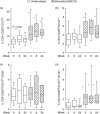Early dynamics of T helper cell cytokines and T regulatory cells in response to treatment of active Mycobacterium tuberculosis infection
- PMID: 25313008
- PMCID: PMC4337678
- DOI: 10.1111/cei.12468
Early dynamics of T helper cell cytokines and T regulatory cells in response to treatment of active Mycobacterium tuberculosis infection
Erratum in
-
Erratum.Clin Exp Immunol. 2015 Jul;181(1):189-90. doi: 10.1111/cei.12653. Clin Exp Immunol. 2015. PMID: 26051743 Free PMC article. No abstract available.
Abstract
Biomarkers that can identify tuberculosis (TB) disease and serve as markers for efficient therapy are requested. We have studied T cell cytokine production [interferon (IFN)-γ, interleukin (IL)-2, tumour necrosis factor (TNF)-α] and degranulation (CD107a) as well as subsets of CD4(+) T regulatory cells (Tregs ) after in-vitro Mycobacterium tuberculosis (Mtb) antigen stimulation [early secretory antigenic target (ESAT)-6, culture filtrate protein (CFP)-10, antigen 85 (Ag85)] in 32 patients with active tuberculosis (TB) disease throughout 24 weeks of effective TB treatment. A significant decline in the fraction of Mtb-specific total IFN-γ and single IFN-γ-producing T cells was already observed after 2 weeks of treatment, whereas the pool of single IL-2(+) cells increased over time for both CD4(+) and CD8(+) T cells. The Treg subsets CD25(high) CD127(low) , CD25(high) CD147(++) and CD25(high) CD127(low) CD161(+) expanded significantly after Mtb antigen stimulation in vitro at all time-points, whereas the CD25(high) CD127(low) CD39(+) Tregs remained unchanged. The fraction of CD25(high) CD127(low) Tregs increased after 8 weeks of treatment. Thus, we revealed an opposing shift of Tregs and intracellular cytokine production during treatment. This may indicate that functional signatures of the CD4(+) and CD8(+) T cells can serve as immunological correlates of early curative host responses. Whether such signatures can be used as biomarkers in monitoring and follow-up of TB treatment needs to be explored further.
Keywords: T cells; Tregs; cytokines; treatment; tuberculosis.
© 2014 The Authors. Clinical & Experimental Immunology published by John Wiley & Sons Ltd on behalf of British Society for Immunology.
Figures





Similar articles
-
T Cell Responses and Regulation and the Impact of In Vitro IL-10 and TGF-β Modulation During Treatment of Active Tuberculosis.Scand J Immunol. 2017 Feb;85(2):138-146. doi: 10.1111/sji.12511. Scand J Immunol. 2017. PMID: 27862137
-
Different immunosuppressive mechanisms in multi-drug-resistant tuberculosis and non-tuberculous mycobacteria patients.Clin Exp Immunol. 2013 Feb;171(2):210-9. doi: 10.1111/cei.12007. Clin Exp Immunol. 2013. PMID: 23286948 Free PMC article.
-
Increased IgG1, IFN-gamma, TNF-alpha and IL-6 responses to Mycobacterium tuberculosis antigens in patients with tuberculosis are lower after chemotherapy.Int Immunol. 2010 Sep;22(9):775-82. doi: 10.1093/intimm/dxq429. Epub 2010 Jul 11. Int Immunol. 2010. PMID: 20624776
-
Functional Signatures of Human CD4 and CD8 T Cell Responses to Mycobacterium tuberculosis.Front Immunol. 2014 Apr 22;5:180. doi: 10.3389/fimmu.2014.00180. eCollection 2014. Front Immunol. 2014. PMID: 24795723 Free PMC article. Review.
-
Th22 response induced by Mycobacterium tuberculosis strains is closely related to severity of pulmonary lesions and bacillary load in patients with multi-drug-resistant tuberculosis.Clin Exp Immunol. 2021 Feb;203(2):267-280. doi: 10.1111/cei.13544. Epub 2020 Nov 18. Clin Exp Immunol. 2021. PMID: 33128773 Free PMC article. Review.
Cited by
-
A united model for diagnosing pulmonary tuberculosis with random forest and artificial neural network.Front Genet. 2023 Mar 9;14:1094099. doi: 10.3389/fgene.2023.1094099. eCollection 2023. Front Genet. 2023. PMID: 36968608 Free PMC article.
-
Helper T cell bias following tuberculosis chemotherapy identifies opportunities for therapeutic vaccination to prevent relapse.NPJ Vaccines. 2023 Oct 28;8(1):165. doi: 10.1038/s41541-023-00761-4. NPJ Vaccines. 2023. PMID: 37898618 Free PMC article.
-
Assessment of treatment response in tuberculosis.Expert Rev Respir Med. 2016 Jun;10(6):643-54. doi: 10.1586/17476348.2016.1166960. Epub 2016 Mar 31. Expert Rev Respir Med. 2016. PMID: 27030924 Free PMC article. Review.
-
Functional and Phenotypic Changes of Natural Killer Cells in Whole Blood during Mycobacterium tuberculosis Infection and Disease.Front Immunol. 2018 Feb 19;9:257. doi: 10.3389/fimmu.2018.00257. eCollection 2018. Front Immunol. 2018. PMID: 29520269 Free PMC article.
-
Identification and validation of a T-cell-related MIR600HG/hsa-mir-21-5p competing endogenous RNA network in tuberculosis activation based on integrated bioinformatics approaches.Front Genet. 2022 Sep 20;13:979213. doi: 10.3389/fgene.2022.979213. eCollection 2022. Front Genet. 2022. PMID: 36204312 Free PMC article.
References
-
- World Health Organization (WHO) 2013. Global Tuberculosis Report . Geneva: WHO; WHO/HTM/TB/2013.13.
-
- Wallis RS, Kim P, Cole S, et al. Tuberculosis biomarkers discovery: developments, needs, and challenges. Lancet Infect Dis. 2013;13:362–372. - PubMed
-
- Gandhi NR, Nunn P, Dheda K, et al. Multidrug-resistant and extensively drug-resistant tuberculosis: a threat to global control of tuberculosis. Lancet. 2010;375:1830–1843. - PubMed
-
- O'Garra A, Redford PS, McNab FW, Bloom CI, Wilkinson RJ, Berry MP. The immune response in tuberculosis. Annu Rev Immunol. 2013;31:475–527. - PubMed
Publication types
MeSH terms
Substances
LinkOut - more resources
Full Text Sources
Other Literature Sources
Research Materials
Miscellaneous

